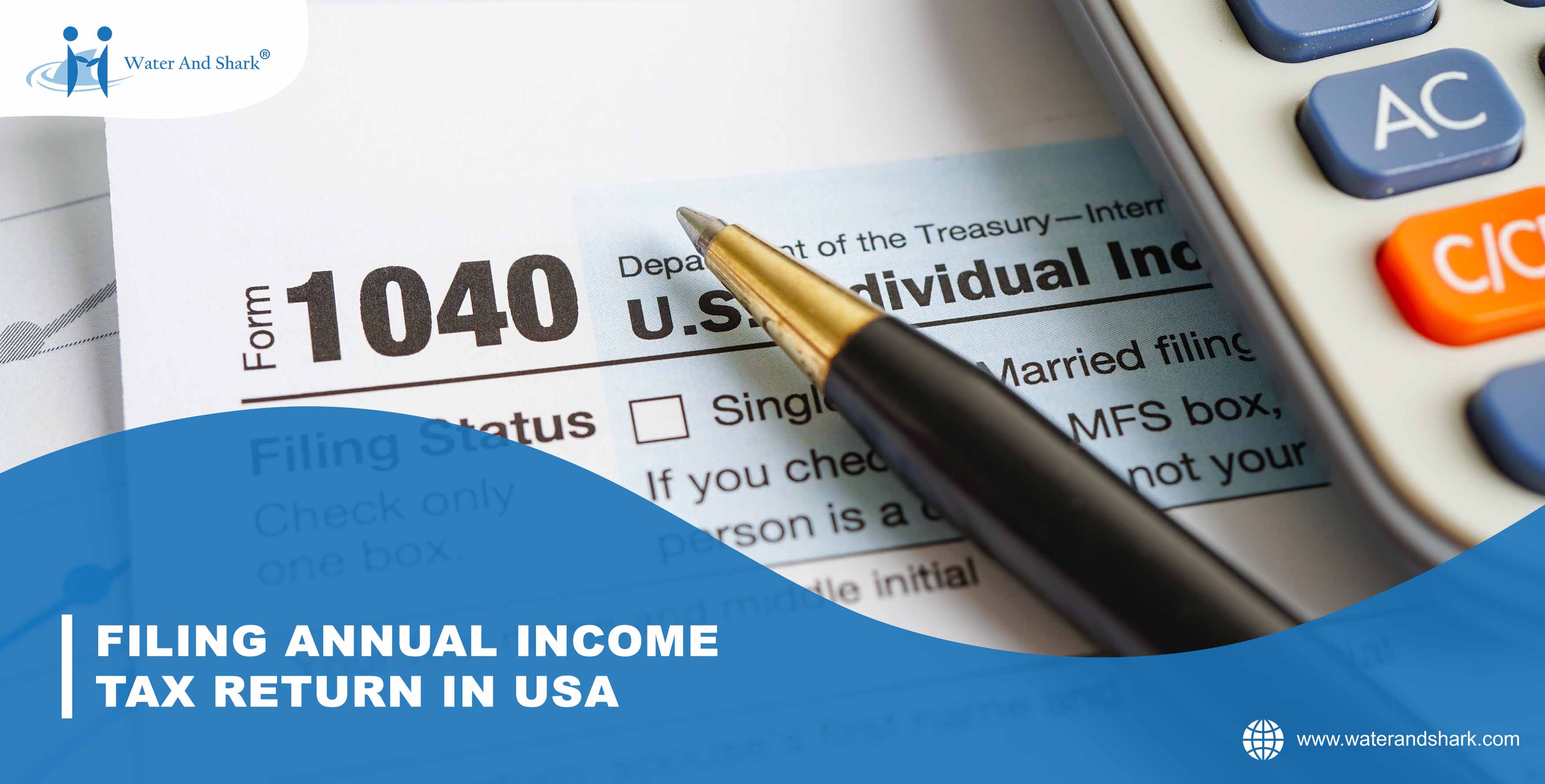FORM 1040: A COMPREHENSIVE GUIDE TO FILE ANNUAL INCOME TAX RETURN IN USA
March 14, 2024 waterandshark
With an onset of tax filing season in the USA, Form 1040 becomes the most important document for filing individual tax returns. Individual and corporate taxes, taxes that are dedicated to funding Social Security and Medicare ate the major contributors to the sources of revenue to the U.S. government. Understanding the IRS Form 1040 can be an unnerving task. However, with the right knowledge and guidance, understanding and filing your federal tax returns can be a more straightforward and a less stressful experience. Let us get into the details to better understand the form 1040.
Jump right in:
What is Form 1040?
Who uses form 1040?
What is the Structure of form 1040?
Threshold limits for filing Form 1040?
What are the different schedules used with Form 1040?
What are the Tax rates for 2023 to be filed in 2024?
What is the due date for filing the Form 1040?
What are the various documents that the taxpayers must keep ready while filing?
What are the most common mistakes to avoid while filing Form 1040?
What are the various documents that the taxpayers must keep ready while filing?
Conclusion
What is Form 1040?
Form 1040 – U.S. Individual Income Tax Return is a form used by Resident Individual taxpayers in the USA to report their incomes and calculate the tax liabilities to file with the IRS. The form requires the individuals to report their Incomes, deductions, tax credits and payments to determine the amount of tax owed or the refund to be received. Form 1040 is more than just a tax document. It is a gateway to better understand your finances in detail.
Who uses form 1040?
Form 1040: Most resident individual taxpayers will use this form to report income and determine their tax liabilities irrespective of their level of income or filing status. (Single, Married filing jointly, married filing separately, etc.)
However, there are a few variations of the Form for different taxpayers:
- Form 1040-SR: This form is an optional alternative to form 1040 for senior taxpayers (age 65 and older) with simplified tax situations. Form 1040-SR is nearly identical to Form 1040 but is printed using a larger fonts and boxes for convenience for filing paper return.
- Form 1040-NR: This form is for non-resident individuals of USA if they have income sources in USA. This form is extensive as compared to Form 1040.
- Form 1040-X: This form is for taxpayers who need to make amendments to correct the errors in the tax return after previously filing a Form 1040, 1040-SR or 1040-NR.
What is the Structure of form 1040?
The form is divided into several parts as mentioned below. Let us understand them in detail:
- Personal credentials: Details such as SSN, Date of Birth, Name, Home address etc of you as well as your spouse in case filing joint returns shall be provided here.
- Income: Information of the income earned through Salaries/Tips, Investments, self-employment income during the relevant year are reported here under.
- Adjustments to income: In this section information pertaining to expenses and allowances to reduce the taxable income that can be claimed are provided.
- Deductions and credits: details of claimable deductions such as child tax credits and such other deductions are to be provided that can be reduced from the Gross Income to reduce the taxable income.
- Tax: This section consists of the calculations final tax obligations on the adjusted income at the appropriate rates.
- Payment/refund: Final tax liability or Refund is calculated after considering all the withholding taxes, pre-paid taxes.
Threshold limits for filing Form 1040?
The form requires most of the individuals with certain levels of gross income to file taxes. If your income exceeds the threshold limits, you are obligated to file form 1040. Below mentioned are threshold limits for the calendar year 2023 as follows:
|
FILING STATUS OF THE TAXPAYER |
AND at the end of 2023 you were |
File if GROSS INCOME was at least |
|
Single |
Under 65 65 or older |
$13,850 $15,700 |
|
Married filing jointly |
under 65 (both spouses) 65 or older (one spouse) 65 or older (both spouses) |
$27,700 $29,200 $30,700
|
|
Married filing separately |
Any age |
$5 |
|
Head of the household |
under 65 65 or older |
$20,800 $22,650 |
|
Qualifying surviving spouse |
under 65 65 or older |
$27,700 $29,200 |
What are the different schedules used with Form 1040?
IRS Form 1040 is structured to capture comprehensive financial information. Depending on the type of income you need to report, it may be necessary to attach additional schedules that has its reference in the respective line items of the form 1040.
Schedule 1: This schedule is an attachment to the form and is used for reporting several common additional income sources or adjustments to income. For e.g. alimony, gains or losses from the sale of a business property, unemployment compensation, business income, educator expenses and health savings account contributions.
Schedule 2: This schedule to the form is used for reporting additional taxes such as Alternative minimum tax, Self-employment taxes, unreported social security and Medicare tax, household employment taxes, repayment of first-time home buyer credit and net investment income tax.
Schedule 3: This schedule is also an attachment to the form and is used for reporting additional credits and payments. Some of such credits and payments are refundable and some are non-refundable. Credits reported here include credits for child and dependent care expenses, residential energy credits, overpayment of taxes in previous years, and previously paid excess social security taxes.
Schedule A to SE are also similar attachments to Form 1040 which contain additional information about bifurcation of the overall income based on the source of such incomes for example, Capital gains, Dividend and interest income, Net profit from businesses.
SCHEDULES A-SE
|
SCHEDULE |
PURPOSE |
|
A |
It is used to enter all itemized deductions. These can include medical and dental expenses, mortgage interest, state and local taxes, charitable donations, and casualty and theft losses. |
|
B |
It is used to report interest and ordinary dividend that is greater than $1,500. If you have interest and dividend income under that amount, this schedule is not required. |
|
C |
It is used for reporting profit or loss from business. It's typically used by independent contractors, freelancers, and owners of sole proprietorships or single-member LLCs. |
|
D |
It is used for reporting capital gains or losses from investments. |
|
E |
It is used for reporting income or losses from rental real estate, royalties, partnerships, S corporations, estates, trusts, REMICs, or other pass-through entities |
|
F |
It is used by farmers to report income and expenses from farming. |
|
H |
It is used by taxpayers with household workers, such as a nanny or caretaker since the taxpayer is responsible for withholding income for social security and Medicare taxes, those are reported here. |
|
J |
It is used by farmers and fisherman who choose to figure their income tax by averaging their three previous years' worth of taxes in order to more evenly distribute tax liability. |
|
R |
It is used for claiming the elderly or disability tax credit |
|
SE |
It is used for business owners or independent contractors who made a profit of at least $400, this form is used to calculate self-employment tax. |
What are the Tax rates for 2023 to be filed in 2024?
|
Tax Rate |
Single |
Married filing jointly |
Married file separately |
Head of household |
|
10% |
$0 to $11,000 |
$0 to $22,000 |
$0 to $11,000 |
$0 to $15,700. |
|
12% |
$11,001 to $44,725 |
$22,001 to $89,450 |
$11,001 to $44,725 |
$15,701 to $59,850. |
|
22% |
$44,726 to $95,375 |
$89,451 to $190,750 |
$44,726 to $95,375 |
$59,851 to $95,350. |
|
24% |
$95,376 to $182,100 |
$190,751 to $364,200 |
$95,376 to $182,100 |
$95,351 to $182,100. |
|
32% |
$182,101 to $231,250 |
$364,201 to $462,500 |
$182,101 to $231,250 |
$182,101 to $231,250. |
|
35% |
$231,251 to $578,125 |
$462,501 to $693,750 |
$231,251 to $346,875 |
$231,251 to $578,100. |
|
37% |
$578,126 or more. |
$693,751 or more. |
$346,876 or more. |
$578,101 or more. |
What is the due date for filing the Form 1040?
The return is due on or before the 15th day of the fourth month after the close of your fiscal year. For e.g. if your fiscal year is the calendar year, then the due date will be 15th April of each AY. For extending the filing date the taxpayers may need to file Form 4868 and seek an extension until October 15. It is to be noted that form 4868 only for extending the filing of returns and not for the payment.
What are the various documents that the taxpayers must keep ready while filing?
It is important to stay ready with all the required documents and personal details for filing the returns with IRS. The most important ones are as follows:
- social security number or tax ID number
- spouse’s full name, social security number or tax ID number, and date of birth
- Identity Protection PIN, if one has been issued to you, your spouse, or your dependent by the IRS.
- Foreign reporting and residency information - if applicable
- If employed- Form W-2
- If unemployed - Unemployment (1099-G)
- If self - employed - Forms 1099, Schedules K-1, Records of all expenses
- Record of all the incomes, expenses, allowances and deductions if not covered by an forms
What are the most common mistakes to avoid while filing Form 1040?
While filing the form it is possible to commit a few errors, however it is important to steer clear of the errors that can lead to penalties. Some errors may invite an audit from the IRS. The best move forward would be to avoid such costly errors while filing the form. Let’s look out for some possible errors that we can avoid.
- Not keeping proper details about your basic personal information in the form:
Personal details which are required during the filing process like:
- Name- Incorrect or misspelled name can lead to complications, but the impact may vary depending on the nature and severity of the errors. The name usually must match with the one mentioned in the Social Security Card.
- Social Security Number- Incorrect SSN can lead to delayed processing, or rejection of the returns, or loss of tax benefits like deductions and can invite increased scrutiny which can be time-consuming.
- Filing status- Filing status for individual taxpayers is bifurcated into single, married and filing jointly or separately, head of household etc. Choosing the correct filing status on your tax return is important because it affects your tax rates, deductions, and the credits you may be eligible for. Incorrect filing status may lead to incorrect tax liability or an IRS review of the returns.
- Home address- Incorrect home address may lead to inaccurate processing of your tax return. It can also lead to communication issues or security concerns. The home address must be in line with a proper zip code.
- Fiscal year- Incorrect fiscal year or financial year may lead to confusion and issues with the processing of your tax return. Fiscal year is the relevant 12-month period used by businessmen and certain individuals for financial reporting and tax purposes.
- Bank account – Incorrect bank account details can lead to delay in issue of refunds.
- Making mathematical errors while tax calculations in the form IRS reported that mathematical errors are one of the most common errors while filing the report. They can be of any sort like any wrong additions or subtractions. Hence double checking is very important before submitting the form.
- Not checking for any typos in the form Typos may happen to anyone hence double checking everything is crucial. Some typos include leaving out any digits, entering wrong digits or any spelling errors are some common typos any taxpayer can make. This might end up being a major mistake in filing with the IRS.
- Not entering brackets for negative amounts in the form If you have to enter an item as a negative number, check the IRS instructions. Some forms prefer a parentheses “()”, while others use the minus symbol “-”. This ensures that IRS computers read the negative entry correctly. Sometimes form may not accept signs of “-” or words like “less” and “minus” for the meaning of deduction or any losses or expenses hence entering brackets is a must or else it would lead to completely wrong tax computation.
Apart from the errors in inputting the data in the form, there are some other things that one should keep in mind while filing the form:
- Submitting your tax return electronically ensures greater accuracy than mailing your return. The e-file system often detects common errors and rejects your tax return, sending it back to you for correction.
- Entering the amounts and figures on the correct lines.
- Signing and mentioning correct date of the return.
- Attaching various forms and schedules viz form W-2, 1099-R, Schedule K-1and such other documents to support your return.
- Not attaching all other necessary schedules and forms in the order of the sequence number shown in the upper right-hand corner.
- Not using the correct mailing address from your tax form instructions.
- Not using the correct postage on the envelope.
- If you're due a refund and requested direct deposit, double-checking the routing and account numbers for your financial institution is crucial.
- Not making a copy of the signed return and all schedules for your own records.
Conclusion:
The golden rule always maintains that the taxpayers must double check the returns before submitting them to the IRS. Even after filing the returns, it is important to keep a copy of your signed return, along with an acknowledgement proof of filing. Furthermore, your past tax returns will come in handy when you file future tax returns or need to file an amended return.
It is imperative to take professional guidance to accurately complete Form 1040 to avoid common filing errors. Reach out to our professional experts at Water and Shark for accurate and smooth tax filing process.





Comment